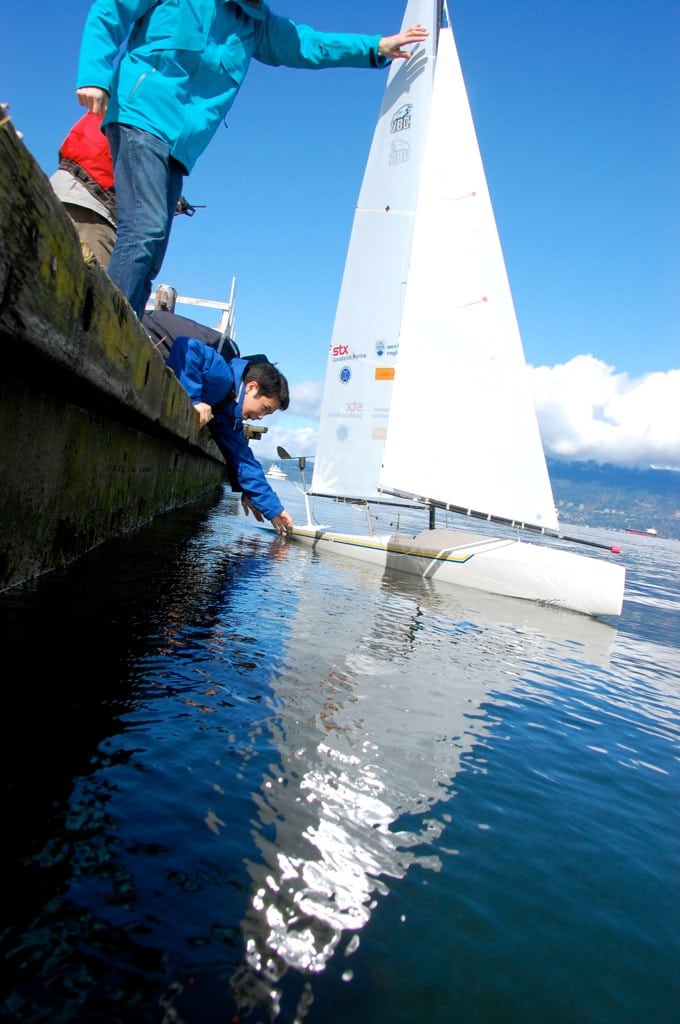
UBC Sailbot
In a couple of months, students from 19 schools will race in Gloucester, Mass. But you won’t find anyone onboard their sailboats. In fact, you won’t even find anyone controlling these boats remotely for part of the competition. Sailbot, which has been held annually since 2006, gives students the opportunity to design boats that sail autonomously. In other words, the boats are programmed by the students to trim sails and change direction to get around the racecourse.
Drew Bennett, a professor of robotics and the Sailbot team‘s mentor at Olin College of Engineering in Needham, Mass., which is hosting Sailbot this year, explains: “The amount of manual control depends on the race. In the fleet race, we allow full manual control. The other contests—navigational accuracy, station keeping, and the long-distance race—they all have to be autonomous.”
Colleges will race in three fleets according to size: 1-meter, 2-meter, and 4-meter. Boats are designed according to a box rule. For example, boats in the 2-meter class must be designed in a box that’s 2 meters long, 3 meters wide, and five meters high, from the tip of the mast to the bottom of the keel. “One team at the Naval Academy [in the 2010 Sailbot regatta] brought a trimaran with a wing sail,” says Bennett. “It didn’t work so well, but they got a special award for innovation. We want to encourage people to experiment.”
Olin College is a newcomer to the competition, having formed a team in 2011 that finished second at the 2012 Sailbot Regatta hosted by the University of British Columbia.
Olin races in Vancouver, B.C., at their first Sailbot regatta. Photo: Olin Sailbot
“It was our first attempt so we patterned our boat after the old America’s Cup 12 Meter hulls,” says Bennett. “We had a fairly large, tubby shape that made it easy to work inside, but we were really slow. This year the team went back to the drawing board and came up with a new hull design.
“Reliability seems to be a big issue for all the teams. I think we got second because our boat never broke down during the race. We weren’t the fastest boat; if we weren’t the hare, we were the tortoise.”
Reliability is a major focus as all the teams prepare for the regatta, which will be held from June 9 to 13. The University of British Columbia Sailbot Team is the defending champion, and a major focus is testing enough to ensure they’ve got a reliable boat to bring to the East Coast. “You can’t be successful unless you test the hell out of it,” says Kristoffer Vik Hansen, captain of the UBC Sailbot team. “Last year we had forty days on the water testing before the competition to go through all the challenges in the competition and try the worst-case scenarios.”
For most on the UBC and Olin teams, the experience is at least a partially novel one. UBC has 30 members on its team, and about half of them sail. “We have some really good sailors who have been to competitions,” says Vik Hansen, “and then we have some people who don’t even know the physics of sailing, but they’re into the engineering challenge.”
On Olin’s 50-member team, only a couple students have sailing experience. “Most of them are robotics geeks,” says Bennett. “Last year they admitted, ‘We have a great robot, but not so great of a sailor.’”
UBC Sailbot team members at the drawing board last November. Photo: UBC Sailbot
Mentors like Bennett help facilitate the experimentation. “We rely heavily on our mentors to help us through the design phase of the project,” says Vik Hansen. “The design comes from all of us having ideas on how to make the boat faster and lighter. Then we go through those ideas with our mentors and see which one is reasonable to do and feasible with the time we have. We go straight into doing sketches; sketches turn into drawings; drawings turn into 3D modeling.”
UBC does a final float test before the deck goes on. Photo: UBC Sailbot
Even when a boat does break down during a competition, the teams pitch in to help each other out, which creates a congenial racing atmosphere. Bennett says of last year’s event, “When one team had a problem with their electronics, other teams were running up with soldering irons, spare components, and advice, offering to help in any way they could.”
This year, high school teams will also participate in the event with 1-meter boats. In fact, a separate team at Olin is creating a boat kit to pass off to US Sailing, which the organization will then support and subsidize to get more high school students involved in sailing and robotics.
Currently, 11 colleges and eight high schools are signed up to sail. You can check out the action at this very different type of collegiate regatta on Gloucester’s waterfront in early June. Maritime Gloucester will be the primary base of operation.
Check out this introduction to the Olin Sailbot Team for more information, and go on board UBC’s boat below:
Go on board UBC’s sailbot at the 2012 competition:









